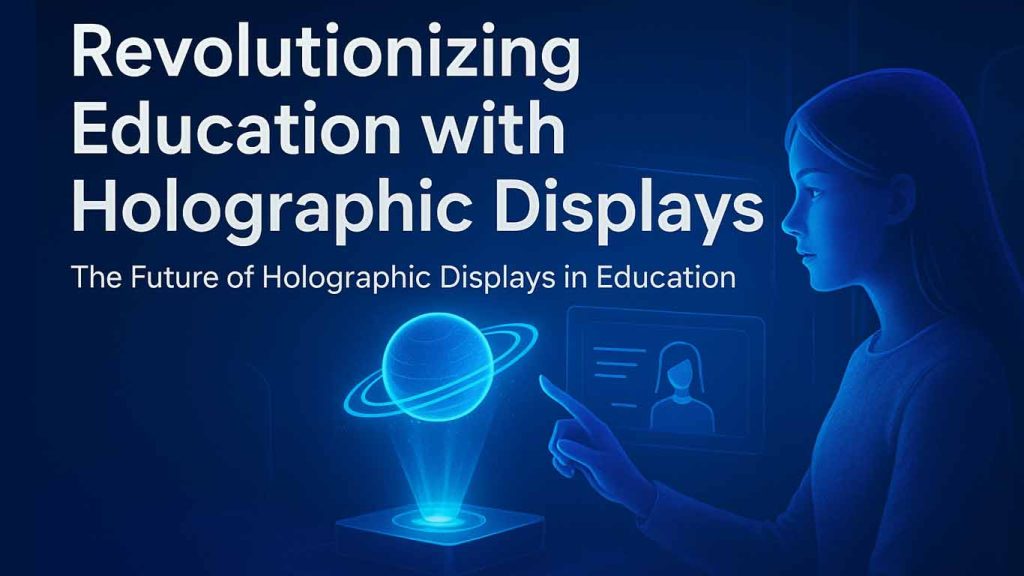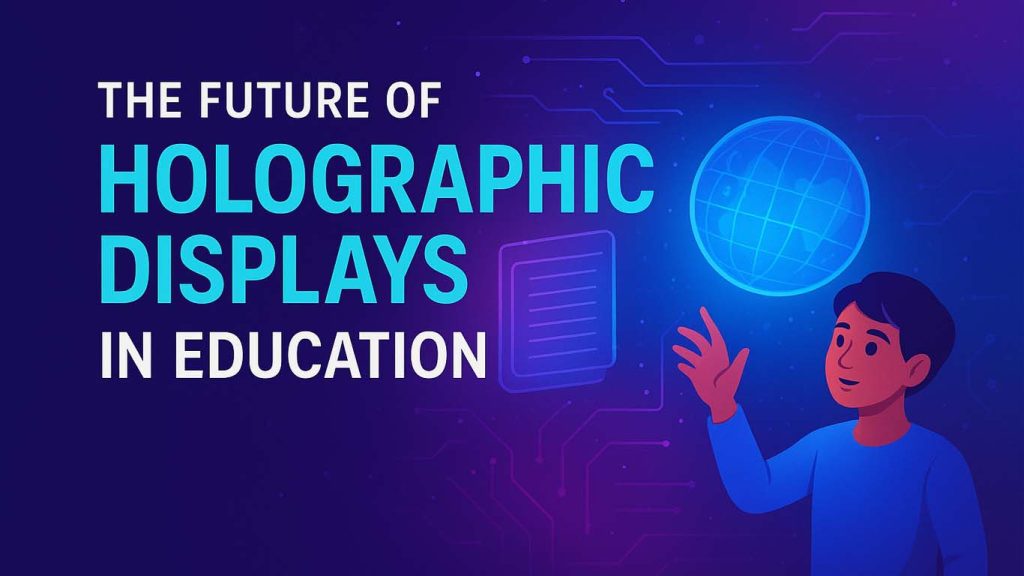
The Future of Holographic Displays in Education
Introduction: The Dawn of a New Learning Era
Education has always evolved alongside technological advancements. From the printing press that democratized knowledge to the rise of the internet and e-learning platforms, each innovation has redefined how learners acquire, interact with, and apply information. Today, we stand at the threshold of another revolutionary transformation: the integration of holographic displays into education.
Holographic displays are no longer confined to the realm of science fiction or futuristic movies. They are fast becoming tangible tools capable of reshaping classrooms and learning experiences across the globe. With their ability to project 3D images in real space without the need for special glasses, holograms provide immersive, interactive, and highly engaging educational opportunities. As the 21st-century classroom shifts toward more personalized, technology-driven models, holographic displays are poised to play a pivotal role in shaping the future of learning.
This blog explores the journey of holographic displays, their applications in education, current challenges, and what the future may hold for this groundbreaking technology.
The Development of Holographic Display Technology
Holography, the science behind holographic displays, was first conceptualized in the 1940s by Hungarian-British physicist Dennis Gabor, who later won the Nobel Prize for his invention. While early holograms required complex setups and lacked practical applications, the integration of lasers in the 1960s made the technology more viable.
Fast forward to the 21st century, advancements in light field technology, photonics, AI, and mixed reality have propelled holography into mainstream use cases. Companies like Microsoft (with HoloLens), Looking Glass Factory, and Light Field Lab are already experimenting with display prototypes that can render lifelike 3D content visible to the naked eye.
The educational sector, always eager to adopt innovations that improve learning outcomes, has emerged as a key arena for the adoption of holographic displays.
Why Holographic Displays Matter in Education
Education thrives on engagement, visualization, and contextual understanding. Traditional textbooks and 2D screens often fall short when it comes to demonstrating complex concepts, such as human anatomy, molecular structures, or historical events. This is where holographic displays excel:
- Immersive Learning – Students can interact with 3D projections of historical figures, scientific models, or even entire ecosystems.
- Enhanced Retention – Studies show that immersive learning can improve knowledge retention by 30–40% compared to traditional methods.
- Global Accessibility – Virtual holographic classrooms can bring world-class education to underserved regions.
- Personalized Learning – Learners can explore content at their own pace, interacting with holographic materials tailored to their unique needs.
By combining visual depth with interactivity, holographic displays are redefining how students learn, collaborate, and retain information.
Applications of Holographic Displays in Education
1. Virtual Classrooms
Imagine attending a lecture where the professor appears as a lifelike hologram, teaching from across the globe. Universities are already experimenting with this model. For example, Imperial College London has piloted holographic lectures, enabling professors to “beam” into classrooms from remote locations. This not only reduces travel costs but also increases access to international expertise.
2. Interactive Simulations
Medical students can now explore a full-sized 3D holographic model of the human body, peeling back layers of muscles, organs, and tissues without needing cadavers. In engineering, learners can deconstruct machines and analyze mechanical parts in real-time holographic simulations.
3. Personalized Tutoring
With holographic displays, AI-powered virtual tutors can provide personalized lessons tailored to each student’s needs. These holographic tutors can demonstrate step-by-step problem-solving techniques, ensuring learners grasp complex concepts.
4. Historical and Cultural Reenactments
History comes alive when learners witness holographic reenactments of key events or interact with holographic representations of historical figures. Instead of passively reading about ancient civilizations, students could walk through a holographic reconstruction of the Roman Colosseum.
5. STEM Education
Subjects like chemistry and physics often involve abstract concepts that are difficult to visualize. Holograms can project molecules, atoms, or quantum processes, giving students a tangible sense of invisible phenomena.

Case Studies: Holography in Action
- University of Illinois Urbana-Champaign has experimented with holographic anatomy teaching tools, allowing medical students to practice procedures virtually.
- The Dubai Future Foundation launched holographic educational initiatives aimed at transforming how students in the UAE experience science and history.
- Microsoft’s HoloLens has been integrated into select classrooms worldwide, where learners interact with mixed-reality holograms for engineering and biology training.
These case studies highlight the transformative potential of holographic displays in education when paired with the right pedagogical strategies.
Challenges in Implementing Holographic Displays
Despite their immense potential, integrating holographic displays into education comes with notable challenges:
1. High Costs
State-of-the-art holographic technology remains expensive. Developing and maintaining holographic classrooms requires significant investment in hardware, software, and training.
2. Technical Infrastructure
Schools in developing regions may lack the bandwidth, power supply, or technological infrastructure needed to support holographic displays.
3. Teacher Training
Educators must be adequately trained to use holographic tools effectively. Without proper pedagogical integration, the technology risks becoming a novelty rather than a meaningful learning aid.
4. Content Creation
Producing holographic educational content requires specialized expertise and resources. Scaling this for multiple subjects and grade levels is still a challenge.
5. Equity and Accessibility
Ensuring that holographic displays do not exacerbate educational inequalities is critical. Wealthier institutions may adopt them quickly, leaving others behind.
Proposed Solutions
- Public-Private Partnerships – Governments, universities, and tech companies can collaborate to subsidize holographic education projects.
- Open-Source Content Platforms – Creating repositories of holographic educational materials accessible to all schools could bridge content gaps.
- Scalable Hardware Solutions – As the technology matures, costs will likely decline, making holographic displays more accessible.
- Teacher Training Programs – Comprehensive training initiatives will ensure that educators maximize the pedagogical potential of holography.
Future Trends in Holographic Displays for Education
Looking ahead, several trends are set to define the role of holographic displays in education:
- Integration with Artificial Intelligence
AI will enable adaptive learning experiences, where holographic tutors adjust lessons based on real-time student performance data. - 5G and Beyond
The rollout of 5G technology will support real-time holographic streaming with minimal latency, enabling global holographic classrooms. - Cross-Disciplinary Collaborations
Expect partnerships between educational institutions, tech companies, and creative industries to develop innovative holographic content. - Gamified Learning
Gamification combined with holography could create engaging and rewarding educational experiences, especially for younger learners. - Democratization of Education
Low-cost portable holographic projectors may eventually allow schools in remote regions to access immersive content, bridging educational divides.
Broader Implications for Education
The adoption of holographic displays will not only transform teaching methodologies but also redefine the very purpose of education. Key implications include:
- Redefining Classrooms – Physical classrooms may evolve into hybrid spaces where physical and holographic elements coexist.
- Cultural Exchange – Students from different continents could engage in shared holographic experiences, promoting cross-cultural understanding.
- Sustainability – Virtual field trips and holographic textbooks could reduce the need for physical resources, promoting environmentally sustainable learning.
Conclusion: A Transformative Future
The rise of holographic displays in education represents more than just a technological upgrade—it signals a paradigm shift in how we approach teaching, learning, and global knowledge-sharing. By enabling immersive, interactive, and personalized educational experiences, holography holds the power to make learning more engaging, equitable, and impactful.
Of course, challenges remain—cost, accessibility, and teacher training among them. But with continued innovation, cross-sector collaboration, and a commitment to democratizing access, the dream of holographic education is well within reach.
In the coming decades, holographic displays may become as commonplace in classrooms as whiteboards or tablets are today. Their transformative potential promises not only to reshape education but also to empower future generations with the tools they need to thrive in a rapidly changing world.
